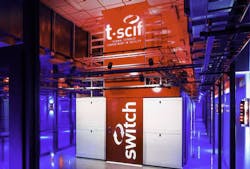Switch License Deal With Schneider Shines Focus on Design Patents
Reflecting its focus on intellectual property, Switch said today that it has licensed several of its patented designs for data center cooling technology to Schneider Electric. In announcing the agreement, Switch also signaled that it stands ready to pursue legal action to defend the patents secured by its founder, Rob Roy.
“Switch’s Policy team licenses Switch technology to those best situated to help lay the foundation for the internet of everything, like Schneider Electric, and we will vigorously defend against unauthorized use,” said Samuel Castor, Executive Vice President of Policy for Switch. “The industry continues to recognize the benefits of Switch’s technology to reduce data center carbon footprints and improve server deployment densities and efficiencies.”
Switch also revealed that it has recently licensed patents to its electric utility provider, NV Energy, which is owned by investment conglomerate Berkshire Hathaway. Switch began its patent licensing program in 2016.
Data Center Patent Disputes Lead to Lawsuits
Patent infringement in data center design has made headlines in recent years through two lawsuits. In 2015, UK engineering firm Bladeroom Group sued Facebook, saying the social networking giant and contractor Emerson Network Power improperly used Bladeroom’s proprietary designs in a data center in Sweden. In 2016, cooling vendor Air Enterprises sued rival Nortek Air Solutions, saying Nortek’s implementation of a cooling system infringed upon its patents for the Kyoto Cooling heat wheel design.
The lawsuits, as well as Switch’s assertive stance on its patents, illustrate the importance of data center design as a differentiator in a highly competitive data center landscape. The cooling designs Roy developed for Switch allow it to support higher power densities in colocation cabinets.
Switch was the dominant player in Las Vegas, but is now expanding into markets where it will compete for business with other large data center developers. As data center customers weigh their options among multiple providers, the benefits of innovative design can often be a key decision point.
Switch had no comment on its next steps in defending its intellectual property. But it is convinced that some providers have drawn upon its ideas in their data center designs.
“Today many companies copy these designs in their data centers, and while Switch is flattered, we are also ramping up our IP legal team to address those that are infringing on our patents,” Castor said in a statement last month.
Focus on Cooling Innovation
The original SUPERNAP expressed Roy’s vision of a new approach to high-density data center design. Built in 2007, the 400,000 square foot data center was most notable for its enormous size, but also showcased new ideas in cooling and aisle containment that Roy developed as he filled six smaller data centers in Las Vegas between 2000 and 2006.
Inside the data hall, Roy’s design for a hot aisle containment system enabled customers to support up to 42 kW per cabinet. The cooling units, who are housed outside the building, are unusually versatile, supporting six different modes of cooling. The software that manages the system selects the most efficient cooling method based on the exterior temperature, humidity and other conditions. The cooling system is supported by a rotary flywheel, which can ensure that the cooling units will continue to move air through the data halls in the event of a utility power outage.
In a recent video, Switch prominently featured the patent numbers for its various design features, including its high-density containment system, multi-mode cooling units and power spine design. The company says Roy has received hundreds of patents.
“Switch believes the licensing of Switch’s technology by third parties further validates Rob Roy’s inventions and status as one of the world’s leading data center designers,” the company said, noting that the license agreement affirms that “Schneider finds Switch’s patents unique and valuable.”
Schneider: Long-Term Partner
Schneider has been one of Switch’s leading equipment partners for years, working on the SUPERNAP’s redundant power system, power and cabinet systems. The license covers all issued patent claims for Switch’s Hot Aisle Containment Chimney and Exterior Wall Penetrating Multi-Mode HVAC technology. The companies said they view the license agreement as “an opportunity to explore future strategic customer/vendor opportunities.”
“This announcement further strengthens our long and growing relationship and provides another opportunity for data center clients to benefit from the combined innovation from Switch and Schneider Electric,” said Chris Hanley, SVP of Data Center Systems for Schneider Electric, who said the licensed technology “will complement Schneider’s product offerings and efficiencies.”
It wasn’t immediately clear whether Schneider would seek to productize the Switch designs and offer them to the broader data center market.
About the Author


